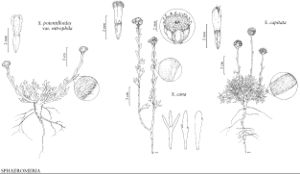Sphaeromeria
Trans. Amer. Philos. Soc., n. s. 7: 401. 1841.
| Taxon | Illustrator ⠉ | |
|---|---|---|
 | Sphaeromeria potentilloides var. nitrophila Sphaeromeria cana Sphaeromeria capitata | Yevonn Wilson-Ramsey Yevonn Wilson-Ramsey Yevonn Wilson-Ramsey |
Perennials or subshrubs, (1–) 5–60 (–70) cm (usually aromatic). Stems 1–5+ (with interxylary cork), lax to erect, branched from bases or throughout, glabrous or sericeous to tomentose (hairs medifixed), usually gland-dotted as well. Leaves mostly basal (sometimes in rosettes) or basal and cauline; alternate; petiolate or sessile; blades obovate to cuneate or linear, usually 1–2-pinnately or palmately lobed (ultimate lobes oblanceolate to linear) or apically 3-toothed or lobed, ultimate margins entire, faces glabrous or ± sericeous to tomentose and usually gland-dotted. Heads disciform, borne singly or (2–60+) in usually corymbiform, rarely paniculiform, arrays or in subcapitate clusters. Involucres hemispheric to campanulate, 3–5 (–12) mm diam. Phyllaries persistent, (8–) 12–20+ in 2–3+ series, mostly obovate, unequal to subequal, margins and apices (colorless, pinkish, or brownish) scarious. Receptacles conic to nearly flat (villous in S. potentilloides), epaleate. Ray-florets 0 (peripheral pistillate florets 4–15+; corollas ± filiform, lobes usually 3). Disc-florets 30–50+, bisexual, fertile; corollas usually bright-yellow (ochroleucous in S. cana), tubes ± cylindric, throats ± campanulate, lobes 5, ± deltate (tips glabrous or hairy). Cypselae columnar or obovoid to obconic, ribs 2–3 or 5–10, faces glabrous or gland-dotted (pericarps with myxogenic cells only in S. potentilloides, without resin sacs); pappi usually 0 (of 3–5 subulate scales in S. compacta). x = 9.
Distribution
w United States, nw Mexico
Discussion
Species 9 (8 in the flora).
Selected References
Lower Taxa
Key
| 1 | Receptacles villous; cypselae becoming mucilaginous when wet | Sphaeromeria potentilloides |
| 1 | Receptacles glabrous; cypselae not mucilaginous when wet | > 2 |
| 2 | Subshrubs, 20–70 cm; leaves mostly cauline (not forming basal clusters) | > 3 |
| 2 | Perennials, 1–20 cm (often cespitose); leaves mostly basal (commonly forming clusters) | > 5 |
| 3 | Corollas ochroleucous, lobes villous | Sphaeromeria cana |
| 3 | Corollas yellow, lobes glabrous or gland-dotted | > 4 |
| 4 | Leaves glabrous; heads 5–20 in corymbiform or subumbelliform arrays (as wide as or wider than long) | Sphaeromeria diversifolia |
| 4 | Leaves tomentose; heads (8–)10–30(–60) in paniculiform arrays (longer than wide) | Sphaeromeria ruthiae |
| 5 | Heads 1–7 (S. argentea) or 8–20 | > 6 |
| 5 | Heads 1–3(–5) | > 7 |
| 6 | Leaf blades (± cuneate, 7–15 mm) entire or apices 3(–5)-toothed or -lobed, faces silvery-canescent; heads usually in subcapitate to corymbiform arrays (1–1.5 cm across), sometimes borne singly | Sphaeromeria argentea |
| 6 | Leaf blades (± cuneate, 8–20 mm) usually 1–2-pinnati-palmately lobed (ultimate lobes ± linear), faces ± tomentose; heads in tight, capitate arrays (1–1.3 cm across) | Sphaeromeria capitata |
| 7 | Leaves: blades (10–25 mm) pinnati-palmately lobed (lobes 3–6+, ± oblanceolate to linear) or linear, faces sericeous (pappi of 3–5, subulate scales) | Sphaeromeria compacta |
| 7 | Leaves: blades (15–30 × 1.5–8 mm) pinnati-palmately lobed (lobes 2–3, linear, 1–2 mm wide) or linear, faces silvery-canescent | Sphaeromeria simplex |